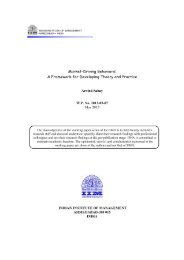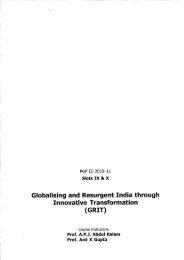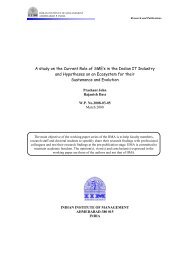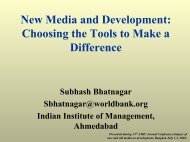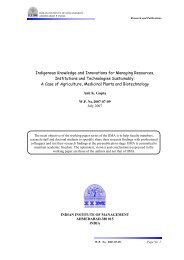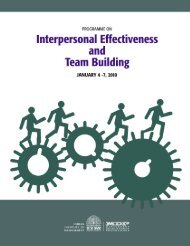Role of Government: As an Enabler, Regulator, and - Indian ...
Role of Government: As an Enabler, Regulator, and - Indian ...
Role of Government: As an Enabler, Regulator, and - Indian ...
You also want an ePaper? Increase the reach of your titles
YUMPU automatically turns print PDFs into web optimized ePapers that Google loves.
<strong>As</strong>i<strong>an</strong> Forum on ICT Policies <strong>an</strong>d e-Strategies<br />
<strong>Role</strong> <strong>of</strong> <strong>Government</strong>:<br />
<strong>As</strong> <strong>an</strong> <strong>Enabler</strong>, <strong>Regulator</strong>, <strong>an</strong>d Provider <strong>of</strong> ICT<br />
Based Services<br />
by<br />
Subhash Bhatnagar<br />
Pr<strong>of</strong>essor,<br />
Indi<strong>an</strong> Institute <strong>of</strong> M<strong>an</strong>agement, Ahmedabad<br />
<strong>As</strong>ia-Pacific Development Information Programme<br />
United Nations Development Programme<br />
www.apdip.net/asi<strong>an</strong>-forum
<strong>Role</strong> <strong>of</strong> <strong>Government</strong>: <strong>As</strong> <strong>an</strong> <strong>Enabler</strong>, <strong>Regulator</strong>, <strong>an</strong>d Provider <strong>of</strong> ICT<br />
Based Services<br />
Subhash Bhatnagar,<br />
Pr<strong>of</strong>essor<br />
Indi<strong>an</strong> Institute <strong>of</strong> M<strong>an</strong>agement, Ahmedabad<br />
Abstract<br />
This paper is written to serve as a basis for discussing the role <strong>of</strong> government: as <strong>an</strong> enabler,<br />
regulator, <strong>an</strong>d provider <strong>of</strong> ICT based services in the <strong>As</strong>i<strong>an</strong> Forum on Information Communication<br />
<strong>an</strong>d Technology Policy <strong>an</strong>d e-Strategies being held at Kuala Lumpur from 20-22 October, 2003.<br />
The paper presents developments in the area <strong>of</strong> e-government in <strong>As</strong>i<strong>an</strong> countries. It discusses the<br />
kind <strong>of</strong> applications that have been developed, benefits that have been delivered, <strong>an</strong>d the reasons<br />
why m<strong>an</strong>y developing countries in the world have been quick in adopting e-government. To<br />
exploit the full potential <strong>of</strong> e-government there are m<strong>an</strong>y challenges. Several factors that are<br />
necessary for building effective e-government applications are identified on the basis <strong>of</strong> <strong>an</strong><br />
<strong>an</strong>alysis <strong>of</strong> success <strong>an</strong>d failures <strong>of</strong> e-government applications that have been developed so far. In<br />
the final section, the paper defines a role for governments in <strong>As</strong>ia that c<strong>an</strong> enable them to exploit<br />
the full potential <strong>of</strong> e-government. The role encompasses a doer’s role-- delivering government<br />
services electronically, <strong>an</strong>d <strong>an</strong> enabling role that encourages private sector to deliver electronic<br />
services. <strong>Government</strong>s need to develop a vision <strong>an</strong>d strategy, create <strong>an</strong> org<strong>an</strong>ization to support<br />
<strong>an</strong>d catalyze e-government, build hum<strong>an</strong> capacity, <strong>an</strong>d enact policies that will attract private<br />
investment in infrastructure <strong>an</strong>d application development.<br />
1. Introduction<br />
There are three different perspectives with which developing countries have viewed information<br />
<strong>an</strong>d communication technologies. The domin<strong>an</strong>t perspective has been one <strong>of</strong> promoting growth<br />
<strong>of</strong> ICTs as one <strong>of</strong> the key sectors <strong>of</strong> a country’s economy. The ICT sector presents a great<br />
opportunity for countries to enh<strong>an</strong>ce economic growth <strong>an</strong>d employment as has been shown by<br />
India. The sector c<strong>an</strong> also become a major source <strong>of</strong> earning foreign exch<strong>an</strong>ge <strong>an</strong>d <strong>of</strong>fer products<br />
<strong>an</strong>d service that c<strong>an</strong> be deployed by other sectors <strong>of</strong> the economy.<br />
A second perspective that has emerged in the last five years is the deployment <strong>of</strong> ICT for<br />
delivering government services. Improvements in delivery <strong>of</strong> <strong>Government</strong> services are <strong>an</strong><br />
import<strong>an</strong>t issue for m<strong>an</strong>y developing countries as the largest cost <strong>of</strong> inefficiency is borne by the<br />
poor. Electronic delivery c<strong>an</strong> improve efficiency, cut delays for citizens, lessen corruption, <strong>an</strong>d<br />
increase tr<strong>an</strong>sparency. Applications that focus on online delivery <strong>of</strong> services to citizens, to<br />
businesses, <strong>an</strong>d to different arms <strong>of</strong> government are covered within the broad definition <strong>of</strong><br />
electronic government. E-government is about a process <strong>of</strong> reform in the way <strong>Government</strong>s work,<br />
share information <strong>an</strong>d deliver services to external <strong>an</strong>d internal clients. Specifically, e-<br />
government harnesses information technologies (such as Wide Area Networks, the Internet, <strong>an</strong>d<br />
mobile computing) to tr<strong>an</strong>sform relations with citizens, businesses, <strong>an</strong>d other arms <strong>of</strong>
government. The resulting benefits c<strong>an</strong> be less corruption, increased tr<strong>an</strong>sparency, greater<br />
convenience, revenue growth, <strong>an</strong>d cost reduction 1 .<br />
The third perspective defines the role <strong>of</strong> electronic media <strong>an</strong>d communication within a society.<br />
Within the ambit <strong>of</strong> this view, governments have to deal with issues such as convergence <strong>of</strong><br />
different technologies, private control over media, <strong>an</strong>d censorship.<br />
This paper is concerned with the second view point that is focussed on the role <strong>of</strong> governments as<br />
<strong>an</strong> enabler, regulator, <strong>an</strong>d provider <strong>of</strong> ICT based services.<br />
2. Reasons for Adoption <strong>of</strong> E-<strong>Government</strong> by Developing Countries<br />
E-government is primarily driven by a vendor/consult<strong>an</strong>t push that st<strong>an</strong>ds to benefit from<br />
increased investments in hardware <strong>an</strong>d consulting. It is also driven by a growing dem<strong>an</strong>d for<br />
better services from citizens, who now experience vastly improved services from the private<br />
sector. Some other factors that have contributed to the growing popularity <strong>of</strong> E-<strong>Government</strong> are<br />
discussed below.<br />
There has been a considerable demonstration effect <strong>of</strong> the constructive difference that e-<br />
government has made in adv<strong>an</strong>ced economies in the delivery <strong>of</strong> services, provision <strong>of</strong><br />
information <strong>an</strong>d internal administration <strong>of</strong> the public sector. M<strong>an</strong>y developing countries that have<br />
developed signific<strong>an</strong>t capacity in building IT applications feel that they c<strong>an</strong> leap frog to take<br />
adv<strong>an</strong>tage <strong>of</strong> the new electronic ch<strong>an</strong>nels that are available for delivering government services.<br />
In the last decade, m<strong>an</strong>y countries have gone through a process <strong>of</strong> economic liberalization <strong>an</strong>d<br />
economic growth under advice from multi-lateral lending agencies. M<strong>an</strong>y large countries like<br />
India <strong>an</strong>d China have grown at 6 to 10 percent over the last decade. Having completed the first<br />
phase <strong>of</strong> economic policy reform, such countries are now under compulsion to move to the next<br />
phase <strong>of</strong> reform i.e. govern<strong>an</strong>ce reform. Since e-government pilots have demonstrated a positive<br />
impact on corruption, tr<strong>an</strong>sparency <strong>an</strong>d quality <strong>of</strong> service, these countries see e-government as <strong>an</strong><br />
effective tool for govern<strong>an</strong>ce reform.<br />
There is signific<strong>an</strong>t intra-governmental competition between government departments that are<br />
eager to move forward in implementing E-<strong>Government</strong>.<br />
These successes are also a source <strong>of</strong> pride. Some countries have already demonstrated, the best<br />
consequence <strong>of</strong> their experimentation <strong>an</strong>d innovation in this field, there is a competition taking<br />
place with developed countries. So, for example, Brazil launched <strong>an</strong> electronic voting system:<br />
they are very proud that it is a better system th<strong>an</strong> that <strong>of</strong> the United States, <strong>an</strong>d it seems this has<br />
become <strong>an</strong> incentive for these countries to catch up with the developed world<br />
Spread <strong>of</strong> the Internet in the urb<strong>an</strong> areas <strong>of</strong> m<strong>an</strong>y developing countries is starting to create a<br />
critical mass, not as considerable as in most developed countries, but large enough to lead the<br />
1 For a comprehensive definition <strong>of</strong> e-government <strong>an</strong>d examples <strong>of</strong> cases where these benefits were delivered, see<br />
World B<strong>an</strong>k web site on e-government .
government to deliver online services. In the large <strong>an</strong>d highly urb<strong>an</strong>ized countries in Latin<br />
America or <strong>As</strong>ia, it has become possible to deliver these services. In some places where e-<br />
government has been introduced, it has shown that it c<strong>an</strong> work, <strong>an</strong>d it c<strong>an</strong> have a wide impact on<br />
government efficiency <strong>an</strong>d effectiveness.<br />
3. Variety <strong>of</strong> Applications <strong>an</strong>d Delivery Models<br />
Applications <strong>of</strong> E-<strong>Government</strong> c<strong>an</strong> be categorized according to the constituency that is served.<br />
Delivery <strong>of</strong> services to citizens: Services have been made convenient, <strong>an</strong>d easy to access Delays<br />
have been reduced. The rules governing service c<strong>an</strong> be made tr<strong>an</strong>sparent, <strong>an</strong>d consistent across<br />
different br<strong>an</strong>ches <strong>of</strong> the same department, M<strong>an</strong>y departments have been able to reduce<br />
corruption through e-government 2 .<br />
Delivery <strong>of</strong> Services to Business <strong>an</strong>d Industry: Business <strong>an</strong>d industry are concerned with the cost<br />
<strong>of</strong> setting up a business. A signific<strong>an</strong>t component <strong>of</strong> this cost is the administrative permissions<br />
<strong>an</strong>d license that must be obtained to establish <strong>an</strong>d operate a business. Electronic delivery c<strong>an</strong> lead<br />
to quick turnaround <strong>of</strong> license applications <strong>an</strong>d lead to <strong>an</strong> overall reduction in costs 3 . Additionally<br />
rules c<strong>an</strong> be made tr<strong>an</strong>sparent <strong>an</strong>d consistent across departments. Corruption, which may form<br />
signific<strong>an</strong>t part <strong>of</strong> costs, c<strong>an</strong> be reduced, making the business more competitive.<br />
Increased Efficiency <strong>of</strong> Departments/ Govt. Enterprises: E-government c<strong>an</strong> lead to lower cost <strong>of</strong><br />
operations <strong>an</strong>d higher productivity. <strong>Government</strong>s in <strong>As</strong>ia are unable to realize the benefit, as they<br />
are unwilling <strong>an</strong>d unable to cut down the number <strong>of</strong> employees after the introduction <strong>of</strong><br />
electronic delivery.<br />
Signific<strong>an</strong>t reduction in costs c<strong>an</strong> result from a paperless environment in which electronic<br />
document flow from workstation to work station for approval <strong>an</strong>d action 4 . There are one-time<br />
costs <strong>of</strong> hardware/s<strong>of</strong>tware <strong>an</strong>d other operating expenses associated with such applications.<br />
Perhaps the maximal cost reduction takes place in storing paper files. The most import<strong>an</strong>t<br />
adv<strong>an</strong>tage is one <strong>of</strong> greater effectiveness because the administrative burden on decision-makers is<br />
lessened, releasing time for import<strong>an</strong>t issues <strong>of</strong> policy <strong>an</strong>d decision making.<br />
Often the data captured by the electronic system enables tighter monitoring <strong>of</strong> productivity <strong>of</strong><br />
employees, easy identification <strong>of</strong> pressure points for delay <strong>an</strong>d corruption, <strong>an</strong>d accumulation <strong>of</strong><br />
2 2 See OPEN case study in Seoul where corruption has been lessened in issue <strong>of</strong> licenses by municipal corporation<br />
by enabling on-line tracking <strong>of</strong> application status combined with several other measures.<br />
Also BHOOMI case in Karnataka, India illustrates<br />
reduction in corruption in issue <strong>of</strong> certificate <strong>of</strong> l<strong>an</strong>d titles to millions <strong>of</strong> farmers<br />
<br />
3 See the examples <strong>of</strong> business registration in China<br />
where the processing time has been cut<br />
signific<strong>an</strong>tly<br />
4 see example <strong>of</strong> SmartGov in Andhra Pradesh Secratariat
historical data that c<strong>an</strong> be easily mined for policy <strong>an</strong>alysis. Another signific<strong>an</strong>t adv<strong>an</strong>tage is the<br />
ability to share data across agencies <strong>an</strong>d departments in <strong>an</strong> electronic form.<br />
Countries have used three distinct delivery models.<br />
Departments going on-line: Here citizens interact with departmental/private operators who access<br />
data <strong>an</strong>d information from on-line terminals located in the premises <strong>of</strong> the department. If care has<br />
been taken to reengineer the back end processes, signific<strong>an</strong>t benefits c<strong>an</strong> be delivered in terms <strong>of</strong><br />
time, costs, <strong>an</strong>d number <strong>of</strong> trips to the department. Such a model tends to result in greater<br />
departmental ownership enabling signific<strong>an</strong>t re-engineering <strong>of</strong> processes. Even though each<br />
department becomes more efficient, for availing different services citizens need to visit a<br />
different departments.<br />
Conveniently located Service Centers in public places: Multiple services are <strong>of</strong>fered at each<br />
location: payment, issue <strong>of</strong> licenses <strong>an</strong>d certificates. Such counters c<strong>an</strong> quickly move traffic from<br />
departmental counters to service center (as happened in the case <strong>of</strong> Brazil 5 ). Building such<br />
centers, which must deal with several departments, requires signific<strong>an</strong>t coordination <strong>an</strong>d perhaps<br />
setting up a separate agency for the project. Services from municipal, state <strong>an</strong>d federal<br />
governments c<strong>an</strong> be <strong>of</strong>fered under one ro<strong>of</strong>. Counters at these service centers are m<strong>an</strong>ned by<br />
public/private agencies. M<strong>an</strong>y countries have outsourced the running <strong>of</strong> these centers to private<br />
operators who add other value-added services like payment <strong>of</strong> insur<strong>an</strong>ce to augment their<br />
income 6 .<br />
Self Service through a Portal: The portals are designed to <strong>of</strong>fer a variety <strong>of</strong> services <strong>an</strong>d the<br />
interface is org<strong>an</strong>ized in a fashion that makes it convenient for citizens to access the services<br />
(using a life cycle approach as in UK <strong>an</strong>d Singapore 7 ). Complete backend computerization is<br />
needed <strong>an</strong>d usually there is a middle ware, which directs requests for access to information from<br />
different departmental data bases/web sites. Integration at the back end is needed for data sharing.<br />
There should be policies governing data definitions, structure <strong>of</strong> data <strong>an</strong>d layered architecture <strong>of</strong><br />
individual departmental applications. Such self-service delivery naturally presumes a high<br />
Internet penetration; willingness <strong>an</strong>d ability <strong>of</strong> citizen to use the Portals. This in turn requires<br />
security <strong>an</strong>d mutual trust (which builds with each successful outcome). M<strong>an</strong>y countries have<br />
experienced a gradual build up <strong>of</strong> usage. C<strong>an</strong>ada had 11% people using the Portal in 2002 even<br />
though 60% citizens have access to Internet. Adoption rate has to be driven through conscious<br />
5 For a detailed description <strong>of</strong> experience with service center locations in Bahia <strong>an</strong>d Sao Paulo in Brazil see <<br />
http://www1.worldb<strong>an</strong>k.org/publicsector/egov/bahiaSAC.htm> <strong>an</strong>d<br />
< http://www1.worldb<strong>an</strong>k.org/publicsector/egov/poupatempo.htm><br />
6 For a detailed description <strong>of</strong> private operators running service centers in Andhra Pradesh, see the description <strong>of</strong> e-<br />
seva centers at 14 location in the city <strong>of</strong> Hyderabad, India< http://www.ap-it.com/eseva.html><br />
7 The government online portal <strong>of</strong> UK is org<strong>an</strong>ized so that a citizen c<strong>an</strong> access services in multiple ways. One <strong>of</strong><br />
these ways is: issues beginning with before the birth <strong>of</strong> a new child, after the birth <strong>of</strong> a child, nursery education, lone<br />
parents, just for dads, adopting <strong>an</strong>d fostering etc. In case <strong>of</strong> Singapore services <strong>an</strong>d information are categorized into<br />
15 etowns which cater to various essential touch-points in life - Business, Defense, Education, Elections,<br />
Employment, Family, Health, Housing, Library, Recreation, Safety & Security, Sports, Tr<strong>an</strong>sport <strong>an</strong>d Travel. For<br />
details see www.ukonline.gov.uk <strong>an</strong>d
actions like training <strong>an</strong>d other incentives. Building a portal requires strong centralized leadership<br />
for extensive co-ordination. Even then the goal <strong>of</strong> a joined up <strong>Government</strong> where a particular<br />
service requires approvals from m<strong>an</strong>y different departments, is difficult to achieve.<br />
4. Some Examples <strong>of</strong> Successful Projects from Different Countries<br />
In m<strong>an</strong>y developing countries, a very large number <strong>of</strong> <strong>Government</strong> departments publish<br />
information on Web sites. By <strong>an</strong>d large these sites are poorly designed, not kept updated, <strong>an</strong>d do<br />
not own responsibility for the quality <strong>of</strong> information. Initially this effort was targeted at attracting<br />
foreign investments, but as Internet penetration grows in urb<strong>an</strong> areas, m<strong>an</strong>y sites focus on<br />
delivering information <strong>an</strong>d services to citizens <strong>an</strong>d businesses. A signific<strong>an</strong>t number <strong>of</strong><br />
developing countries from <strong>As</strong>ia <strong>an</strong>d Latin America have implemented tr<strong>an</strong>saction oriented e-<br />
government applications on a pilot basis. A few <strong>of</strong> these pilots in Chile, India, Brazil, South<br />
Korea have been replicated on a wider scale.<br />
The table below <strong>an</strong>alyzes documented case studies <strong>of</strong> e-government applications from different<br />
developing countries. The table lists the countries where such applications have been developed<br />
<strong>an</strong>d identifies a few benefits that have been realized. These applications represent the low<br />
h<strong>an</strong>ging fruit; applications that deliver signific<strong>an</strong>t benefit <strong>an</strong>d yet are not difficult to implement.<br />
TABLE-I<br />
Application Examples Social <strong>an</strong>d Economic Impact<br />
1. Delivering Citizen services<br />
Payment <strong>of</strong> property taxes, Issue<br />
<strong>of</strong> L<strong>an</strong>d titles<br />
CARD in AP,<br />
Karnataka,<br />
Maharashtra,<br />
BHOOMI in<br />
Karnataka<br />
Income tax on-line Singapore, Brazil,<br />
Jord<strong>an</strong>, Chile, Mexico<br />
Issue <strong>of</strong> driving license, motor Citizen Service Center<br />
registration, passport, birth (Mobile <strong>an</strong>d inshopping<br />
Malls)<br />
certificates, social security <strong>an</strong>d<br />
collection <strong>of</strong> fines<br />
On-line issue/payment <strong>of</strong><br />
electricity, phones, <strong>an</strong>d water<br />
bills, <strong>an</strong>d fines<br />
Bahia, Brazil, FAST<br />
in Hyderabad, Gujarat,<br />
Karnataka<br />
E-Seva in Hyderabad,<br />
FRIENDS in Kerala<br />
2. Delivery <strong>of</strong> services to Business <strong>an</strong>d Industry<br />
E-procurement Mexico, Philippines,<br />
Bulgaria, Brazil <strong>an</strong>d<br />
Chile<br />
New business registration Jord<strong>an</strong>, Jamaica,<br />
China<br />
Tr<strong>an</strong>sparency, faster processing for<br />
citizens, reduced corruption,<br />
increased productivity for <strong>of</strong>fices<br />
Convenient, quicker refunds,<br />
Better compli<strong>an</strong>ce, cost savings<br />
Cut delays, several services under<br />
one ro<strong>of</strong>, reduced corruption,<br />
reduction <strong>of</strong> intermediaries<br />
Convenient locations, quicker<br />
processing time, customer does<br />
m<strong>an</strong>y tasks in one visit<br />
Reduce advertisement costs, lower<br />
costs due to better prices,<br />
tr<strong>an</strong>sparency<br />
Cut down time <strong>an</strong>d number <strong>of</strong><br />
visits, Convenience on filing tax<br />
returns/ quicker refunds
Application Examples Social <strong>an</strong>d Economic Impact<br />
Tax collection (sales tax, VAT,<br />
<strong>an</strong>d corporate Income tax)<br />
Gujarat check post,<br />
Cameroon, Chile<br />
Singapore <strong>an</strong>d<br />
Mauritius<br />
Customs on-line<br />
A total <strong>of</strong> 70 countries<br />
such as India, Jamaica<br />
Philippines, Tunisia<br />
<strong>an</strong>d Mauritius<br />
Trade facilitation Dubai, Yemen ,<br />
Tunisia Mauritius <strong>an</strong>d<br />
Singapore<br />
Cut down time <strong>an</strong>d number <strong>of</strong><br />
visits, convenience on filing tax<br />
returns/quicker refunds, Increase in<br />
revenue collection for <strong>Government</strong><br />
Quicker clear<strong>an</strong>ce, less corruption<br />
Quick turnaround <strong>of</strong> ships in ports<br />
Municipal services OPEN Seoul Quick permissions <strong>an</strong>d issue <strong>of</strong><br />
Municipalities in licenses, access <strong>an</strong>d permissions<br />
India, <strong>an</strong>d Latin<br />
Americ<strong>an</strong> countries<br />
3. Internal efficiency: E-mail <strong>an</strong>d electronic work flow in <strong>Government</strong><br />
Use <strong>of</strong> email <strong>an</strong>d video M<strong>an</strong>y government Usage is low, Faster<br />
conferencing<br />
<strong>of</strong>fices<br />
communication, less travel<br />
Document m<strong>an</strong>agement <strong>an</strong>d work<br />
flow for paperless operations<br />
SmartGov in AP Speed <strong>of</strong> file disposal, traceably <strong>of</strong><br />
actions, greater accountability<br />
4. Empowering Citizens through Access to Information<br />
Publishing budgets central <strong>an</strong>d Argentina, India <strong>an</strong>d Greater tr<strong>an</strong>sparency<br />
municipal level<br />
Turkey<br />
Publishing project-wise P<strong>an</strong>chayat web sites in Tr<strong>an</strong>sparency <strong>an</strong>d lower corruption<br />
expenditure, executing agency Karnataka<br />
Services through rural kiosks<br />
Market information, Application<br />
Forms, complaints , ecommerce<br />
1000 kiosks in a dozen<br />
pilots in India, pilots<br />
in Latin America <strong>an</strong>d<br />
Africa<br />
Save travel time, lessen corruption,<br />
Better negotiating power,<br />
increased accountability, <strong>an</strong>d<br />
access to markets<br />
5. How to build successful e-government applications?<br />
Signific<strong>an</strong>t Process Reengineering Required: For successful reforms the existing methods <strong>an</strong>d<br />
procedures need to be mapped. Often, different br<strong>an</strong>ches <strong>of</strong> the same department do not use the<br />
same procedures as local context <strong>an</strong>d conditions result in variations being introduced over time.<br />
An import<strong>an</strong>t aspect <strong>of</strong> initiating e-government is to document the existing procedures, simplify<br />
them in a m<strong>an</strong>ner that task c<strong>an</strong> be completed in as few steps as possible without compromising on<br />
the basic purposes. Often, the tasks are carried out in a mech<strong>an</strong>ical fashion because with time, the<br />
original purpose <strong>of</strong> carrying out these tasks has been lost or forgotten. This entire process <strong>of</strong><br />
simplification <strong>of</strong> documents <strong>an</strong>d workflow, points <strong>of</strong> approval <strong>an</strong>d audit is termed as<br />
reengineering. Most <strong>of</strong> the e-government applications which have proved to be successful in<br />
reducing total processing time, <strong>an</strong>d curtailing costs, have done so through a subst<strong>an</strong>tial<br />
reengineering <strong>of</strong> their processes. Such reengineering must precede <strong>an</strong>y exercise in automation.
The end result <strong>of</strong> reengineering may be to modify processes resulting in fewer steps <strong>an</strong>d fewer<br />
people to perform the tasks. It me<strong>an</strong>s that the way the civil serv<strong>an</strong>ts were working earlier needs to<br />
be modified. Introduction <strong>of</strong> technology also me<strong>an</strong>s ch<strong>an</strong>ges in the way work is done. All this<br />
produces a considerable resist<strong>an</strong>ce from the lower levels <strong>of</strong> civil serv<strong>an</strong>ts. A great challenge in<br />
implementing e-government is to overcome this resist<strong>an</strong>ce through education <strong>an</strong>d training. E-<br />
government projects have to consciously strive to provide benefits to civil serv<strong>an</strong>ts at this level,<br />
as they are the ones that tend to lose power <strong>an</strong>d authority over citizens when electronic delivery<br />
<strong>of</strong> service is introduced. E-government projects need to focus on making the entire process <strong>of</strong><br />
decisions making more tr<strong>an</strong>sparent. Because <strong>of</strong> automation, the workflow is regulated <strong>an</strong>d <strong>of</strong>ten<br />
civil serv<strong>an</strong>ts lose the flexibility to deal with applications in <strong>an</strong>y sequence other th<strong>an</strong> the one<br />
dictated by the computerized workflow. This takes away the power <strong>of</strong> patronage <strong>an</strong>d inability to<br />
expedite work. On the other h<strong>an</strong>d, inability to stall work c<strong>an</strong> be noticed easily because both the<br />
public <strong>an</strong>d the supervisors now have the capacity to track information <strong>an</strong>d application as they<br />
move from work station to work station.<br />
Successful implementation <strong>of</strong> projects requires that there is a clear focus on the purpose for<br />
which the application is being built. The intended beneficiaries <strong>of</strong> the application are identified<br />
<strong>an</strong>d benefits that will accrue to the stakeholders are concretized. In fact, specific benefits like<br />
reduction in time or number <strong>of</strong> trips to <strong>an</strong> <strong>of</strong>fice need to be targeted <strong>an</strong>d made public. It is only<br />
then that the process <strong>of</strong> reengineering c<strong>an</strong> work towards <strong>an</strong> ultimate goal.<br />
Strong Project M<strong>an</strong>agement skills are needed within the department. Project m<strong>an</strong>agers need to<br />
clearly identify goals <strong>an</strong>d benefits in concrete terms. The task is <strong>of</strong>ten vast, not m<strong>an</strong>ageable<br />
within the resources that are available internally to a <strong>Government</strong> department. Adoption <strong>of</strong><br />
established st<strong>an</strong>dards <strong>an</strong>d protocols c<strong>an</strong> minimize customization. If <strong>of</strong>-the-shelf s<strong>of</strong>tware is<br />
available it should be used instead <strong>of</strong> reinventing the wheel 8 . Systems <strong>an</strong>alysis, which provides<br />
the necessary cues for reengineering, should be done internally. Design, s<strong>of</strong>tware development,<br />
data preparation, training, etc. c<strong>an</strong> be easily outsourced.<br />
Training expenses should not be minimized. Successful projects typically spend about 10% <strong>of</strong> the<br />
budget on training 9 . Awareness about benefits <strong>of</strong> E-government has to be created in senior civil<br />
serv<strong>an</strong>ts <strong>an</strong>d political executives. Training is required for Project leaders who need to define<br />
project deliverables, deal (negotiate) with consult<strong>an</strong>ts <strong>an</strong>d vendors, <strong>an</strong>d m<strong>an</strong>age <strong>an</strong> outsourced<br />
development process. Clerical staff needs to be trained on specific applications. Supervisors <strong>an</strong>d<br />
m<strong>an</strong>agers need to be trained on using information. Citizens need to be made aware <strong>of</strong> on-line<br />
services <strong>an</strong>d how to tr<strong>an</strong>sact business on Portals<br />
Partnership with private sector c<strong>an</strong> be useful as the private sector has signific<strong>an</strong>t experience in<br />
developing IT applications. Several types <strong>of</strong> partnership arr<strong>an</strong>gements c<strong>an</strong> be used. For smaller<br />
countries it may be possible to find a single partner for the entire effort (not just a specific<br />
8 For example, m<strong>an</strong>y countries have implemented s<strong>of</strong>tware called ASYCUDA developed by UNCTAD for<br />
implementing online customs clear<strong>an</strong>ce. <br />
9 The case study on Computer Aided Registration <strong>of</strong> Deeds (CARDS) on the World B<strong>an</strong>k web site provides details <strong>of</strong><br />
expenditure on various facets <strong>of</strong> implementation.
project) for developing a strategy, producing guidelines for design, reengineer processes,<br />
developing s<strong>of</strong>tware, helping in procurement <strong>an</strong>d providing training. Otherwise multiple partners<br />
may be used for different tasks. The choice <strong>of</strong> partners c<strong>an</strong> vary from multi national m<strong>an</strong>agement<br />
consult<strong>an</strong>ts, IT vendors, <strong>an</strong>d local comp<strong>an</strong>ies. The task for partners c<strong>an</strong> be defined in m<strong>an</strong>y ways.<br />
Partners may be asked to build; or to build <strong>an</strong>d operate; or to build operate <strong>an</strong>d tr<strong>an</strong>sfer. Whatever<br />
the partnering arr<strong>an</strong>gement, it must lead to building <strong>of</strong> local capacity. If private sector partners<br />
are involved, contracts should be drawn in a way that is fair <strong>an</strong>d equitable for both parties—the<br />
<strong>Government</strong> <strong>an</strong>d the private sector. The private sector is entitled to reasonable pr<strong>of</strong>its.<br />
Electronic government does not me<strong>an</strong> that all the steps in the delivery <strong>of</strong> a service should be<br />
h<strong>an</strong>dled electronically. Signific<strong>an</strong>t benefits c<strong>an</strong> be derived by h<strong>an</strong>dling a few <strong>of</strong> the critical<br />
components electronically, e.g. in Chile the e-procurement system <strong>an</strong>nounces the requirements <strong>of</strong><br />
the government on a web site, but h<strong>an</strong>dles the bids in a m<strong>an</strong>ual mode. However, registered<br />
suppliers for the needed product/service are sent <strong>an</strong> email to broaden the choice <strong>of</strong> suppliers.<br />
Once the bids have been processed m<strong>an</strong>ually, the results are <strong>an</strong>nounced electronically on a web<br />
site. Signific<strong>an</strong>t costs have been saved in Chile because <strong>of</strong> exp<strong>an</strong>ded supplier choice <strong>an</strong>d making<br />
the whole process <strong>of</strong> selection <strong>of</strong> suppliers more tr<strong>an</strong>sparent. Yet the core process <strong>of</strong> bidding<br />
continues to be m<strong>an</strong>ual 10 . There are m<strong>an</strong>y examples where some components <strong>of</strong> <strong>an</strong> electronic<br />
service delivery continue to be h<strong>an</strong>dled m<strong>an</strong>ually 11 . Yet, in all these examples signific<strong>an</strong>t benefits<br />
have been delivered to the users in terms <strong>of</strong> reduced time <strong>an</strong>d less corruption.<br />
6. E-government Readiness: <strong>Role</strong> <strong>of</strong> <strong>Government</strong>s<br />
There are several dimensions to e-government readiness. One aspect <strong>of</strong> readiness is the maturity<br />
<strong>of</strong> technical infrastructure <strong>an</strong>d back <strong>of</strong>fice use in various departments. For example, use <strong>of</strong> email<br />
across <strong>Government</strong> departments, would be indicative <strong>of</strong> readiness. Readiness also depends on<br />
the attitudinal make up <strong>of</strong> the civil service. Willingness to reengineer, share more information,<br />
<strong>an</strong>d treat the citizen as a customer indicates high readiness. Attitudinal ch<strong>an</strong>ges are difficult to<br />
bring about, unless there is a champion at the political level <strong>an</strong>d strong leadership within the<br />
department. Departmental champions need to be identified <strong>an</strong>d co-ordination committees created<br />
at departmental levels. A final aspect <strong>of</strong> readiness is <strong>an</strong> aware <strong>an</strong>d dem<strong>an</strong>ding citizenry, which<br />
underst<strong>an</strong>ds its rights, is willing to express them <strong>an</strong>d to fight for them in case <strong>of</strong> laxity <strong>an</strong>d<br />
inefficiency. By publishing perform<strong>an</strong>ce data <strong>an</strong>d citizen charters, e-government c<strong>an</strong> be <strong>an</strong><br />
instrument in promoting citizen awareness.<br />
Delivering e-government services requires a high penetration <strong>of</strong> Internet in homes or presence <strong>of</strong><br />
a large number <strong>of</strong> public kiosks. For h<strong>an</strong>dling e-payment <strong>an</strong>d building trust between citizens <strong>an</strong>d<br />
government in doing tr<strong>an</strong>sactions over long dist<strong>an</strong>ce requires <strong>an</strong> enabling legal framework.<br />
10 For more details on the Chile<strong>an</strong> e-procurement system <strong>an</strong>d the site operated by a private sector comp<strong>an</strong>y, please<br />
see < http://www1.worldb<strong>an</strong>k.org/publicsector/egov/eprocurement_chile.htm>.<br />
11 For most <strong>of</strong> the applications documented by the World B<strong>an</strong>k site, payment is made in the traditional m<strong>an</strong>ner. For<br />
example radio frequency auction in C<strong>an</strong>ada <strong>an</strong>d US are done on line in a multi-staged process, but the final payment<br />
by the successful bidder still comes in as a check
The role that governments have to play in enh<strong>an</strong>cing the readiness for electronic delivery <strong>of</strong><br />
services encompasses a doer’s role-- delivering government services electronically, <strong>an</strong>d <strong>an</strong><br />
enabling role that encourages private sector to deliver electronic services. <strong>Government</strong>s need to<br />
develop a vision <strong>an</strong>d strategy, create <strong>an</strong> org<strong>an</strong>ization to support <strong>an</strong>d catalyze e-government, build<br />
hum<strong>an</strong> capacity, <strong>an</strong>d enact policies that will attract private investment in infrastructure <strong>an</strong>d<br />
application development.<br />
Developing a vision <strong>an</strong>d strategy: <strong>Government</strong>s have to choose application areas where<br />
electronic service delivery will be promoted. <strong>Government</strong>s <strong>of</strong>ten identify those services where<br />
citizen contact is large or very frequent. Often departments that are known to be corrupt are also<br />
high on priority. The priority is linked with the overall political objective <strong>of</strong> the government –<br />
whether it is to attract investment, appear to be tackling corruption effectively, or to increase<br />
revenues from tax collection. Trial through a few quick strike projects is import<strong>an</strong>t, as the<br />
benefits need to be demonstrated to citizens <strong>an</strong>d civil serv<strong>an</strong>ts. Such pilots also help in<br />
underst<strong>an</strong>ding the key step <strong>of</strong> reengineering processes <strong>an</strong>d m<strong>an</strong>aging ch<strong>an</strong>ge in a local context.<br />
E-government c<strong>an</strong> be built in stages after a big picture is in place. First, on-line service delivery is<br />
provided within a set <strong>of</strong> chosen departments. Later m<strong>an</strong>y <strong>of</strong> these services are delivered on-line,<br />
under one ro<strong>of</strong>, at conveniently located centers. Then all the services are web enabled <strong>an</strong>d <strong>of</strong>fered<br />
through a single portal. An assessment <strong>of</strong> the networking infrastructure <strong>an</strong>d Internet penetration is<br />
necessary to determine the kind <strong>of</strong> delivery models that are viable. Building e-government<br />
through these stages requires a great deal <strong>of</strong> coordination amongst departments. Ministerial level<br />
co-ordination committees need to be formed. M<strong>an</strong>aging expectations <strong>an</strong>d maintaining credibility<br />
is import<strong>an</strong>t.<br />
No government is completely ready on all the above dimensions. Some governments therefore<br />
hesitate to make a beginning. Experience <strong>of</strong> some countries like Mauritius, Jord<strong>an</strong> suggests that<br />
org<strong>an</strong>ization <strong>an</strong>d coordination c<strong>an</strong> be overemphasized at the expense <strong>of</strong> action in<br />
implementation 12 . This lack <strong>of</strong> bal<strong>an</strong>ce between pl<strong>an</strong>ning <strong>an</strong>d action c<strong>an</strong> result in demoralization<br />
amongst the champions.<br />
Departmental ownership <strong>of</strong> e-government is vital because no external agency c<strong>an</strong> drive the kind<br />
<strong>of</strong> ch<strong>an</strong>ge that is needed in implementing e-government. However, if the implementation <strong>of</strong> e-<br />
government is left entirely to a department, then resources get wasted, <strong>an</strong>d data sharing may be<br />
hampered. This would make it difficult to deliver those services where a large amount <strong>of</strong><br />
documents <strong>an</strong>d data must be shared across departments in the delivery <strong>of</strong> a service such as<br />
licensing for a beach hotel. Also, each <strong>an</strong>d every department may not have the capacity to use<br />
the correct method <strong>an</strong>d latest design techniques in developing the application. E-government<br />
effort should therefore be supported by a central agency, which c<strong>an</strong> provide necessary guid<strong>an</strong>ce<br />
in use <strong>of</strong> correct methodology. For countries where a central support agency needs to be created,<br />
the role, m<strong>an</strong>date, <strong>an</strong>d size <strong>of</strong> the central support agency needs to be defined. Its appropriate<br />
home has to be established. Some <strong>of</strong> the tasks to be performed by a central agency are: assessing<br />
<strong>an</strong>d enh<strong>an</strong>cing preparedness; developing a strategy, implementation pl<strong>an</strong>; building shared<br />
infrastructure; finding resources for re-engineering, application development <strong>an</strong>d ch<strong>an</strong>ge<br />
12 This observation is based on e-government mission work carried out in these countries by the author on behalf <strong>of</strong><br />
the World B<strong>an</strong>k <strong>an</strong>d the Commonwealth Secretariat.
m<strong>an</strong>agement, developing guidelines, st<strong>an</strong>dards <strong>an</strong>d best practices, developing public private<br />
partnership, identifying departmental champions, monitoring progress <strong>an</strong>d impact, <strong>an</strong>d<br />
overseeing a few quick strike projects.<br />
One <strong>of</strong> the import<strong>an</strong>t steps in preparation for e-government is the building <strong>of</strong> capacity within the<br />
government to m<strong>an</strong>age the implementation <strong>of</strong> projects. States like Andhra Pradesh in India,<br />
which is considered as pioneer in implementation <strong>of</strong> e-government, has invested heavily in the<br />
training <strong>of</strong> chief information <strong>of</strong>ficers. Andhra Pradesh has trained nearly 100 h<strong>an</strong>dpicked <strong>of</strong>ficers<br />
at the middle <strong>an</strong>d senior levels in 3-4 month intensive residential programs. These trainees are<br />
expected to take leadership positions for implementing e-government across 70 departments <strong>of</strong><br />
the state. The training provided <strong>an</strong> exposure to technology so that the trainees could comfortably<br />
deal with private sector partners in procuring various products <strong>an</strong>d services. Analysis <strong>an</strong>d design<br />
<strong>of</strong> systems, m<strong>an</strong>agement for projects, reengineering <strong>of</strong> administrative processes <strong>an</strong>d m<strong>an</strong>agement<br />
<strong>of</strong> ch<strong>an</strong>ge are the other import<strong>an</strong>t topics covered in these training programs.<br />
<strong>Government</strong>s also need to create <strong>an</strong> incentive system so those departments take a lead in<br />
implementing electronic service delivery. Policies need to be defined which enable departments<br />
to charge a user fee when the quality <strong>of</strong> delivery is signific<strong>an</strong>tly upgraded. If the departments are<br />
allowed to retain the user fee <strong>an</strong>d make investments to build new delivery systems – this c<strong>an</strong><br />
serve as a strong incentive for e-government applications.<br />
Systematic evaluation studies need to be conducted to measure benefits during <strong>an</strong>d after<br />
implementation. So far the benefits <strong>of</strong> e-government have been largely <strong>an</strong>ecdotal. Evaluation<br />
studies should be carried out by independent agencies. Stakeholders must indicate the benefits<br />
that have been delivered <strong>an</strong>d problems that continue to be faced. Serious evaluations c<strong>an</strong> provide<br />
feedback for a national strategy, as well as design <strong>an</strong>d implementation <strong>of</strong> individual projects.<br />
Some <strong>of</strong> the projects that were deemed to be successful (<strong>an</strong>d were awarded prizes by international<br />
org<strong>an</strong>izations) have started faltering. A World B<strong>an</strong>k sponsored evaluation <strong>of</strong> four projects in<br />
India indicates that two projects are moving towards a failure 13 . Long term sustainability c<strong>an</strong> be<br />
ensured if the innovation is not championed by just one individual administrator but is owned by<br />
the entire department<br />
E-<strong>Government</strong> c<strong>an</strong> adv<strong>an</strong>ce the agenda on Govern<strong>an</strong>ce <strong>an</strong>d fiscal reform, tr<strong>an</strong>sparency, <strong>an</strong>ticorruption,<br />
empowerment <strong>an</strong>d poverty reduction. The potential is recognized but implementation<br />
is difficult. Pioneers in several countries have shown that gains c<strong>an</strong> be real <strong>an</strong>d projects c<strong>an</strong> be<br />
implemented successfully. The challenge is to promote widespread use.<br />
13 See the evaluation reports at



